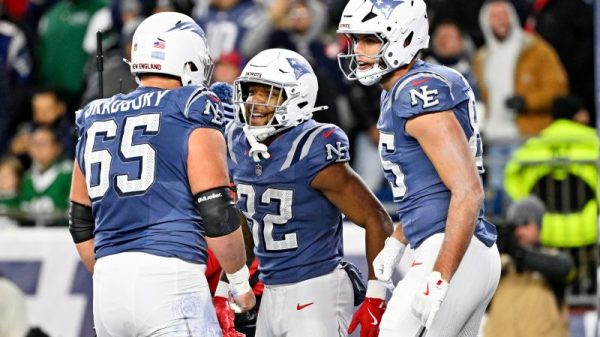The SEC and Big Ten commissioners are evaluating the College Football Playoff format. Two words sum up whether the conferences want this format to continue: We’ll see.
SEC, Big Ten wield biggest sticks in determining future College Football Playoff format. This current format is on the books for this season and next, but then it’s open to change.
Big Ten Commissioner Tony Petitti says he’ll be watching how playoff committee considers strength of schedule when awarding bids.
NASHVILLE, Tenn. – Do the SEC and Big Ten want this current 12-team College Football Playoff format to extend beyond next season?
Neither conference boss would answer that question Thursday.
SEC Commissioner Greg Sankey offered two words in response to whether he’d like to continue this format past next season.
“We’ll see,” Sankey said.
Commissioners and athletics directors from the Big Ten and SEC gathered for a summit here Thursday to discuss topics including the future format of the playoff, the possibility of more Big Ten vs. SEC nonconference matchups, and the implications of the House legal settlement that will unlock revenue-sharing for athletes.
The commissioners had plenty to say about private equity, with both Sankey and Big Ten counterpart Tony Petitti slamming the idea of third-party investors taking the reins of college football’s direction.
They had far less to say about their preference for the playoff format, but their meeting and remarks afterward amounted to a show of strength that could be interpreted as: Either the playoff committee rewards the Big Ten and SEC with a sizable number of at-large bids, or else Sankey and Petitti could bust out their collective sledgehammer and smash this format.
“Who qualifies, how the committee evaluates strength of schedule,” Petitti said, as to what he’ll be closely monitoring from the playoff process this season.
WEEKEND FORECAST: Expert picks for every Top 25 game in Week 7
MAJOR KEY: The one indicator that predicts transfer quarterback success
The current playoff format guarantees automatic bids for the top five conference champions. The remaining seven playoff spots are decided via at-large selection by a 13-member selection committee.
“I want to see what happens with the evaluation (of those at-large bids),” Sankey said.
Teams seeded Nos. 5 through 8 will host first-round games. The top four conference champions will receive a bye.
This format ensures participation from a minimum of five conferences, but it does not guarantee any more than one bid to any conference. Mathematically, a conference could qualify up to eight teams, but a conference qualifying up to four or five teams seems like a more realistic ceiling.
This format is approved for this season and next. After next season, the format is subject to change. The future format will not feature a field smaller than 12 teams, but it could be more. And, how bids are assigned could evolve, too.
“Our focus on future format comes after we go through this first cycle of the expanded College Football Playoff,” Sankey said.
The Big Ten and SEC don’t enjoy unilateral control over the playoff format, but they wield the biggest sticks in determining the playoff’s direction.
“We do have a defined role where we have to be clear participants at the end of the conversation,” Sankey said, regarding the Big Ten and SEC’s role in influencing the future playoff format.
And, at least by appearances Thursday, the leaders of these two conferences plan to be united as they offer that final word in determining the future playoff format.
Representatives from other conferences were not present at Thursday’s summit. Sankey stressed that the SEC and Big Ten are not working toward a full-fledged separation from the other conferences.
“I think that’s a created perception,” Sankey said. “… We recognize that we’re part of a bigger ecosystem, but we’re also interested in what we might achieve together.”
And, together, they could bend the future playoff format to something more to their liking, if they decide they desire a change.
What about more Big Ten vs. SEC football games?
Sankey had a thought while in Ann Arbor, Michigan, last month, waiting for Texas-Michigan to begin: Why not do this type of SEC vs. Big Ten matchup more often?
Historically, the SEC and Big Ten have not played an abundance of non-conference football games, but that’s changing. This season, the conferences met for four non-conference matchups. Three were played on campus sites, while LSU and Southern California met in Las Vegas.
There are three games slated for 2025 with Oklahoma hosting Michigan, Ohio State traveling to Texas and Wisconsin visiting Alabama after playing the Crimson Tide at home this season. Five Big Ten vs. SEC games are scheduled for 2026.
Sankey and Petitti sound interested in increasing the number of Big Ten vs. SEC matchups. Non-conference games pitting teams from those conference superpowers tend to draw big television ratings.
Such matchups also collectively boost the strength of schedule of each conference.
Four SEC schools play annual rivalry games against ACC opponents: Florida-Florida State, South Carolina-Clemson, Kentucky-Louisville and Georgia-Georgia Tech. Sankey acknowledged those existing non-conference matchups and expressed no desire to interrupt those series.
“We respect where we have in-state rivalries that take place in non-conference scheduling,” Sankey said, “but we had a real general conversation about the what-ifs in football and basketball.”
The commissioners also discussed the possibility of increasing the number of Big Ten vs. SEC matchups in other sports other than football and basketball.
Traditionally, individual schools’ athletic department officials enjoy autonomy over non-conference football scheduling, but Petitti and Sankey are evaluating whether the conference offices should get involved in making Big Ten vs. SEC matchups happen.
“The conversation is, is there a structure where the two league offices work together to create more of those matchups?” Petitti said, without answering his own question.
Much like the playoff format conversation, the answer seems to be: We’ll see.
Blake Toppmeyer is the USA TODAY Network’s national college football columnist. Email him at BToppmeyer@gannett.com and follow him on Twitter @btoppmeyer.
Subscribe to read all of his columns.
(This story has been updated with additional information.)



























